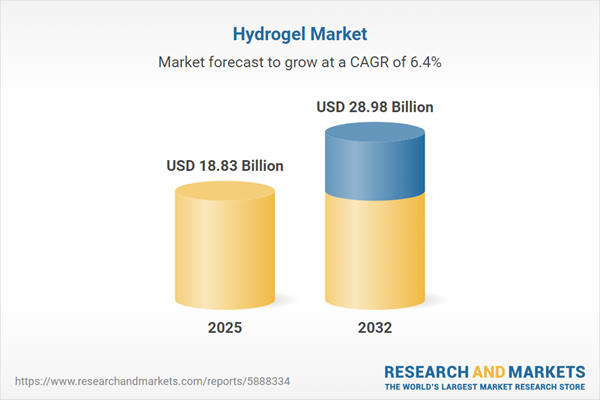Speak directly to the analyst to clarify any post sales queries you may have.
The hydrogel market is evolving as a strategic focus for businesses seeking advanced, sustainable materials for a range of high-value applications. Senior leaders evaluating growth opportunities in this sector benefit from targeted insights into the unique drivers shaping competitive dynamics and future success.
Market Snapshot: Hydrogel Market Size, Growth Trajectory, and Competitive Outlook
The hydrogel market grew from USD 17.70 billion in 2024 to USD 18.83 billion in 2025. It is expected to continue expanding at a CAGR of 6.35%, reaching USD 28.98 billion by 2032. Industry advancement stems from the transformative properties of hydrogels—engineered polymers with outstanding water retention, high permeability, and versatile form factors. Major end-use sectors such as healthcare, agriculture, hygiene, and personal care drive this broad, cross-vertical growth. The competitive landscape is marked by established chemical companies alongside nimble innovators leveraging sustainability and new functionalities to differentiate their hydrogel offerings.
Scope & Segmentation: Strategic Hydrogel Market Landscape
This report provides comprehensive coverage of technologies, product variants, application scenarios, physical forms, and key routes to market. Market segmentation addresses:
- Product Types: Acrylic acid-based, polysaccharide, polyvinyl alcohol, and superabsorbent polymer hydrogels. Each type features distinct material properties, from water uptake to biocompatibility, supporting specialized industrial and healthcare needs.
- Applications:
- Agriculture, including drip irrigation, seed coating, and soil amendment solutions for water management.
- Cosmetics and personal care, such as hair care and skin care product formulations.
- Hygiene products for adult incontinence, baby diapers, and feminine hygiene.
- Wound care, covering acute wound care, burn treatment, and chronic wound management.
- Forms:
- Beads (macro and micro sized) for controlled release.
- Pellets (macro and micro) adapted for automated processes.
- Powder (granular or micro powder) for injectables, sprays, or topical application.
- Sheets (bulk and thin film) for layering in medical and hygiene uses.
- Distribution Channels:
- Offline: Hospitals and clinics, pharmacies, and retail stores.
- Online: Company websites and e-commerce platforms, reflecting digital procurement trends.
- Regions:
- Americas (North America, Latin America), Europe, Middle East & Africa, and Asia-Pacific. The report details regional production hubs, regulatory trends, and consumption patterns, highlighting localized demand and suppliers across key economies.
Key Takeaways: Strategic Insights for Hydrogel Market Stakeholders
- Hydrogels offer a unique value proposition across diverse industries, from smart medical interventions to resource-efficient agriculture, by combining adjustable permeability, mechanical integrity, and biocompatibility.
- Technological advancements—such as stimuli-responsive and nanocomposite hydrogels—enable tailored solutions for personalized medicine, advanced wound care, and responsive release systems.
- Sustainability is a growing priority, with investment in bio-based monomers and biodegradable hydrogel systems on the rise, supporting environmental mandates and lifecycle stewardship.
- Leaders in the sector include a mix of multinational chemical corporations and innovative mid-cap firms targeting specific application niches and leveraging collaborative research models.
- Digital sales channels are gaining importance, creating streamlined pathways for buyers seeking detailed specifications, price transparency, and scalable procurement options.
- Emerging regulatory frameworks require robust compliance, especially for hydrogel products in medical, agricultural, and consumer environments.
Tariff Impact: Navigating U.S. Trade Policy Changes
Forthcoming U.S. tariff schedules in 2025 are set to impact hydrogel input costs and supply chain strategies. Adjusted duties on key raw materials are prompting manufacturers to re-evaluate supplier networks, explore nearshoring, and invest in process optimization. Agility in sourcing and proactive cost management will be crucial for protecting margins and maintaining competitive positioning in the face of changing trade dynamics.
Methodology & Data Sources
The findings in this hydrogel market research draw on a robust combination of primary interviews with industry participants and deep secondary analysis. The approach involved direct engagement with manufacturers, suppliers, and regulatory specialists, complemented by reviews of scientific literature, patent records, and import-export data. Validation workshops with sector experts ensured actionable and reliable insights for strategic business decision-making.
Why This Report Matters
- Enables leaders to benchmark hydrogel innovation, supply chain strategies, and regulatory developments across global markets.
- Highlights growth opportunities by mapping product advancements, application diversity, and emerging channels that drive new revenue streams.
- Guides organizations in developing R&D and commercial roadmaps aligned with sustainability priorities and evolving end-user demands.
Conclusion
The hydrogel market offers actionable opportunities and challenges for executive decision-makers pursuing sustainable growth. With competitive pressure, evolving regulations, and expanding applications, leaders can position for long-term success by leveraging innovation and adaptable market strategies.
Additional Product Information:
- Purchase of this report includes 1 year online access with quarterly updates.
- This report can be updated on request. Please contact our Customer Experience team using the Ask a Question widget on our website.
Table of Contents
3. Executive Summary
4. Market Overview
7. Cumulative Impact of Artificial Intelligence 2025
Companies Mentioned
The companies profiled in this Hydrogel market report include:- 3M Company
- Johnson & Johnson Services, Inc.
- Dow Inc.
- DuPont de Nemours, Inc.
- Evonik Industries AG
- Arkema S.A.
- Merck KGaA
- Ashland Inc.
- Sika AG
- DSM-Firmenich N.V.
Table Information
| Report Attribute | Details |
|---|---|
| No. of Pages | 193 |
| Published | November 2025 |
| Forecast Period | 2025 - 2032 |
| Estimated Market Value ( USD | $ 18.83 Billion |
| Forecasted Market Value ( USD | $ 28.98 Billion |
| Compound Annual Growth Rate | 6.3% |
| Regions Covered | Global |
| No. of Companies Mentioned | 11 |









